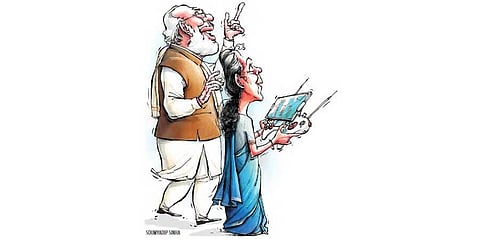

February 1 is the single-most important day in India's fiscal calendar.
The much-awaited Union Budget is presented amid cheers and jeers, but what follows next rarely gets the spotlight.
From the day of presentation till they are approved, budget proposals remain just that. They are mere projections and assume legal sanctity only about two months later, when both the houses namely, Lok Sabha and Rajya Sabha give the stamp of approval.
Though often considered procedural, the two-month wait-period is like a loaded pistol in hand, as the Members of Parliament (MPs) hold a lethal weapon that can shoot down not just the budget proposals, but the government itself.
India, modeled on the Westminister style of governance, empowers the MPs to keep an eagle eye on how the nation's finances are raised and spent. And their financial oversight is a two-stage process.
The first involves MPs scrutinizing and sanctioning the government's expenditure and taxation proposals presented in the Union Budget with assistance from parliamentary committees. The second and the most powerful oversight mechanism involves the Comptroller Auditor General (CAG), which audits the government's accounts every financial year and tables nearly 40 audit reports that are further examined by the Public Accounts Committee.
The first step sets into motion soon after the budget presentation with a general discussion in both the houses. But the discussion is procedural and the Finance Minister concludes it with replies on clarifications sought by the MPs. This year, a general discussion was held in Lok Sabha and Rajya Sabha for about 15 and 11 hours respectively.
No voting takes place at this stage and Parliament goes into a recess for a few weeks. Behind the scenes though, this break time is when the 24-odd department-related Parliamentary Standing Committees are pressed into action to analyze the detailed expenditure estimates of respective ministries, called Demands for Grants.
The Committees are entitled to seek additional information from ministries, and also from industry experts and submit reports with views and recommendations, which in turn help MPs understand the implications of the budget proposals. This is essential and allows for informed debate before approving the expenditure proposals. For instance, this year, the Standing Committee on Defence met four times between February 16 and March 14 to scrutinize budget proposals and Ministry of Defence's Demand for Grants. It observed a shortfall of approximately Rs 1 lakh crore in FY23 budget allocations for defence and recommended that a method be put in place by the Ministry of Defence in consultation with the Ministry of Finance to ensure pragmatic budgetary projections.
Usually, Lok Sabha holds a detailed discussion on a handful of Demands for Grants, and the ministries identified for discussion vary every year (see box below) and are decided by the Business Advisory Committee of Lok Sabha. This is followed by voting, which brings us to the most-important leg of the Parliamentary procedure.
MPs are empowered to express their disapproval via a tool called the 'cut motion'. If it's passed, it signifies loss of confidence in the government, forcing the Cabinet to resign. MPs can move cut motions to reduce the grant amount for a given Ministry -- to Rs 1 to signify their disapproval, or by a specific amount (an 'Economy cut') or by a token amount of Rs 100 to express a specific grievance. Fortunately, a cut motion was never called in at least in the last two decades.
The demands, which have not been discussed and voted on by the last day are 'guillotined,' i.e., they are voted upon together. Curiously, in 2005, 2014 and 2019, all Demands for Grants were guillotined, or passed without discussion.
After the Demands for Grants are passed, they are consolidated into an Appropriation Bill, which authorises the government to spend money from the Consolidated Fund of India comprising receipts and borrowings. Finally, the Finance Bill, including changes in tax rates, is also taken up for consideration and passing. Once Lok Sabha passes the budget, Rajya Sabha only has a recommendatory role in passing the Appropriation and Finance Bills as they are Money Bills.
During the year, if the government needs to spend additional money, it introduces Supplementary Demands for Grants. Though presented in the Parliament, they aren't scrutinised by Standing Committees. For instance, the supplementary demand this fiscal stood at 8% of the total FY23 Budget of Rs 39.4 lakh crore, as against 19% in FY21.
Box:
-- In 2022, Demand for Grants related to Ministries of Railways, Road Transport and Highways, Civil Aviation, Commerce and Industry and Ports, Shipping and Waterways were discussed and adopted individually in the Lok Sabha, while the rest were put to vote on March 24, 2022.
-- The related Appropriation Bill was also introduced, considered and passed on March 24, while the Finance Bill, 2022 was passed the next day in Lok Sabha.
-- A few days later, the Rajya Sabha returned the Finance Bill, 2022 and the Appropriation Bill, 2022 on March, 29 -- just days before the beginning of the new financial year.